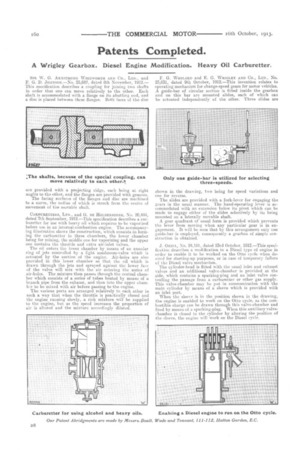Patents Completed.
Page 20

If you've noticed an error in this article please click here to report it so we can fix it.
A Wrigley Gearbnx. Diesel Engine Modification. Heavy Oil Carburetter.
STR W. G. ARMSTRONG 'WHITWORTH AND CO., LTD., and F. G. D. JOITNSON.—No. 25,687, dated 8th November, 1912.— This specification describes a coupling for joining two shafts in order that one can move relatively to the other. Each shaft is accommodated with a flange on its abutting end, and a disc is placed between these flanges. Both faces of the disc are provided with a projecting ridge, each being at right angles to the other, and the flanges are provided with grooves. The facing surfaces of the flanges and disc are machined to a curve, the radius of which is struck from the centre of movement of the movable shaft.
CARBURETTERS, LTD., and G. DE HOLDENSTONE, No. 20,444, dated 7th September, 1912.—This specification describes a carburetter fur use with heavy oil which requires to be vaporized before use in an internal-combustion engine. The accompanying illustration Sh.CFAVS the construction, which consists in forming the carburetter in three chambers, the lower chamber being for mixing, the middle one for vaporizing and the upper one contains the throttle and extra air-inlet valves.
The oil enters the lower chamber by means of an annular ring of jets controlled by a light mushroom-valve which is actuated by the suction of the engine. Air-holes are also provided in this lower chamber so that the oil which is drawn through the jets and sprayed against, the lower face of the valve will mix with the air entering the series of air-holes. The mixture then passes through the central chamber which consists of a series of tubes heated by means of a branch pipe from the exhaust, and then into the upper ehamb2r to be mixed with air before passing to the engine. The various ports are arranged relatively to each other in such a way that when the throttle is practically closed and the engine running slowly, a rich mixture will be supplied to the engine, but as the speed increases the proportion of air is altered and the mixture accordingly diluted. F. G. 'WOOLARD and E. G. WRIGLEY AND CO., LTD., No. 23,031, dated 9th October, 1912.—This invention relates to operating mechanism for change-speed gears for motor vehicles. A guide-bar of circular section is fitted inside the gearbox and on this bar are mounted slides, each of which can be actuated independently of the other. Three slides are shown in the drawing, two being for speed variations and one for reverse.
The slides are provided with a fork-lever for engaging the gears in the usual manner. The hand-operating lever is accommodated with an extension below its pivot which can be made to engage either of the slides selectively by its being mounted on a laterally movable shaft.
A gear quadrant of usual form is provided which prevents the lever from moving when any particular gear is in engagement. It will he seen that by this arrangement only cue guide-bar is employed, consequently a gearbox of simple construction is obtained.
J. (runt, No. 24,181, dated 23rd October. 1912.—This specification describes a modification to a Diesel type of engine in order to enable it to be worked on the Otto cycle when desired for starting-up purposes, or in case of temporary failure of the Diesel valve mechanism.
The cylinder-head is fitted with the usual inlet and exhaust valves and an additional valve-chamber is provided at the side, which contains a sparking-plug and an inlet valve controlling the passage from a carburetter or other gas supply. This valve-chamber may be put in communication with the main cylinder by means of a sleeve which is provided with an inlet port. When the sleeve is in the position shown in the drawing, the engine is enabled to work on the Otto cycle, as the combustible charge can be drawn through this valve-chamber and fired by moans of a sparking-plug. When this auxiliary valvechamber is closed to the cylinder by altering the position of the sleeve, the engine will work on the Diesel cycle.




















